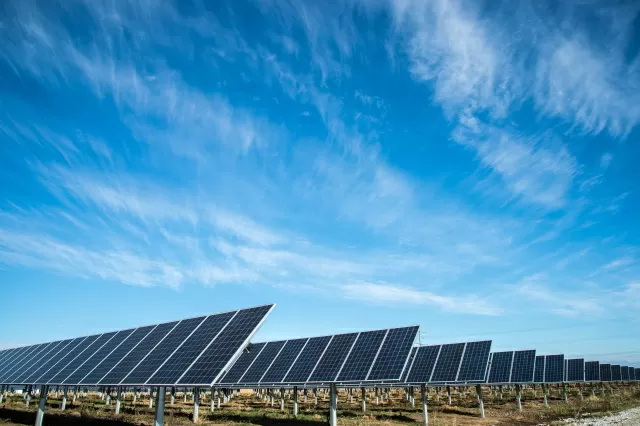Check out our White Paper Series!
A complete library of helpful advice and survival guides for every aspect of system monitoring and control.
1-800-693-0351
Have a specific question? Ask our team of expert engineers and get a specific answer!
Sign up for the next DPS Factory Training!

Whether you're new to our equipment or you've used it for years, DPS factory training is the best way to get more from your monitoring.
Reserve Your Seat TodayClean energy is a future that we constantly strive towards. However, monitoring the clean energy industry is a challenge due to the following issues:
Combining the factors above with the fact that your in-house maintenance crew needs to be constantly updated with instructions about new equipment, SCADA systems start to sound complicated. However, a good SCADA system and manufacturer will be able to mitigate all your fears

SCADA (Supervisory Control and Data Acquisition) monitors and controls your industrial systems, including clean energy. It includes:
The biggest benefit to owning a SCADA system is that you can remotely monitor and control your equipment. This saves you valuable time and money.
You are also sending all information to a centralized location, this means that you will be able to offer your in-house crew a flexible and easily understood human-machine interface (HMI).
The first step to monitoring our hypothetical windmill farm would be collecting data. This means that you will need to monitor:
Afterward, that data needs to be sent to an RTU (remote telemetry unit). The RTU at each wind turbine will communicate with your SCADA's central system by using your communication network. There are multiple ways to set up networks, and you may even want network redundancy. Examples of a network are:
Once you have your network in place, you need to communicate using Modbus, DNP3, or any other standard protocol for your industry's communication.
Finally, you would annunciate this data to a master station where it would present the information to your in-house crew in an easy-to-read format.
Photovoltaic (PV) arrays can be monitored by SCADA systems. You can use SCADA to monitor parameters such as solar irradiance, which is the power per area unit that is received from the sun.
You can also monitor panel temperature and voltage output to make sure that your PV arrays are functioning correctly.
That information would then be transported through an RTU over DNP3 or Modbus.
All RTUs monitoring your solar panels would then report back to the SCADA master station and display to your in-house crew on an HMI.
SCADA systems effectively monitor water levels in Hydroelectric Dams via monitoring:
This ultimately helps in optimizing dam operations, managing water flow, and preventing overflow or shortages.
Run-of-River Hydroelectric Systems utilize SCADA (Supervisory Control and Data Acquisition) systems to efficiently manage the flow of water through turbines.
These systems not only regulate water flow but also closely monitor energy output, ensuring maximum electricity generation while minimizing the environmental impact.
By employing precise control mechanisms, Run-of-River Hydroelectric Systems play a crucial role in sustainable energy production and contribute to the preservation of our natural resources.
A good SCADA system will include the following:
Aside from the key points above, you want to ensure that your SCADA system being provided by your manufacturer has sensors and other types of environmental measurement equipment to give you full visibility of your equipment.
Choosing the right SCADA manufacturer for you is the most important step when shopping for a monitoring solution. After all, the equipment you install is only as good as the manufacturer.
When you choose a good manufacturer, you ensure efficiency and reliability. Part of being a reliable SCADA system is having good customer support.
A good manufacturer will be glad to help get your system back up and running, especially in emergencies. This includes training your team, providing in-depth documentation, and 24/7 customer support.
You may also want to look for manufacturers that offer you:
Partnering with the right manufacturer for your clean energy SCADA monitoring needs ensures that you set your operation up for automated success.
DPS Telecom is a SCADA system manufacturer that expands your growth potential. At DPS, we offer you the same capabilities but at different storage levels and price tags.
For example, we have multiple tiers of RTUs that will perfectly fit your budget, whatever it may be, without compromising your required monitoring power.
In addition, we offer site visits, training seminars, and comprehensive documentation to empower your in-house technicians and maintenance crew. They will be able to restore your online operations in the event of any malfunction.
We also provide you with 24/7 emergency tech support in the event of an RTU or master station failing. Our service and equipment are our reputation, and we want to do it justice.
DPS Telecom offers you everything you need to monitor your oxygen trimming, and we also set you up for success with our 30% off RTU trade-in program so that we can nurture a long-running relationship.
Although our RTUs end up being replaced due to newer technology being available instead of a device failure, we will trade your older RTU for a new one for a 30% discount no matter the condition.
If you would like to know more about how we can fully monitor and service your oxygen trimming with our SCADA systems, or if you have a similar but different application that you think we can monitor for you, give me a call now.
In the unlikely event that we can't find a solution working together, I will still do my best to point you in the correct direction
Call today at 1-800-693-0351 or E-mail me at sales@dpstele.com

Ziad Alezabi
Ziad Alezabi is a Application Documentarian at DPS Telecom. He reviews successful DPS client projects and reports on the best practices that you can use to successfully reach your own project goals.